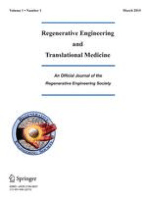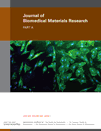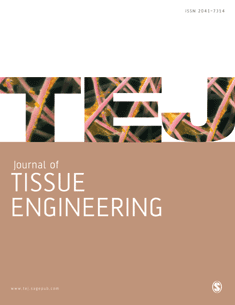
Journal of Tissue Engineering and Regenerative Medicine
Scope & Guideline
Empowering researchers with impactful insights in tissue engineering.
Introduction
Aims and Scopes
- Tissue Engineering Techniques:
The journal emphasizes various tissue engineering techniques, including 3D bioprinting, scaffold design, and hydrogels to create artificial tissues and organs. - Stem Cell Research:
A significant focus is on the application of stem cells, particularly mesenchymal stem cells (MSCs), in regenerative therapies, exploring their differentiation capabilities and therapeutic potential. - Biomaterials Development:
Research on novel biomaterials, including natural and synthetic polymers, is prominent, aiming to enhance biocompatibility and functionality in tissue repair and regeneration. - Mechanobiology:
The journal explores the role of mechanical forces and bioengineering in influencing cell behavior, tissue growth, and regeneration, integrating engineering principles with biological systems. - Regenerative Medicine Applications:
It covers translational research in regenerative medicine, focusing on clinical applications of engineered tissues and the use of growth factors and other biological signals to promote healing. - Wound Healing and Repair:
Research on methods to enhance wound healing, including the use of scaffolds, growth factors, and cell therapies, is a critical area of interest. - Immunomodulation in Tissue Engineering:
The journal discusses strategies to modulate immune responses in tissue engineering applications, ensuring successful integration and function of engineered tissues.
Trending and Emerging
- 3D Bioprinting and Advanced Manufacturing:
Research on 3D bioprinting techniques is rapidly increasing, focusing on the fabrication of complex tissue structures and organoids, enhancing customization and functionality. - Exosome and Extracellular Vesicle Research:
There is a growing interest in the role of exosomes and extracellular vesicles in cell communication and tissue repair, highlighting their potential as therapeutic agents. - Bioactive and Smart Biomaterials:
Emerging studies are centered on the development of smart biomaterials that respond to environmental stimuli, improving the efficacy of tissue regeneration. - Gene Editing and Stem Cell Engineering:
The application of gene editing technologies, such as CRISPR, in stem cell research is gaining momentum, enabling precise modifications that enhance therapeutic outcomes. - Mechanobiology and Biophysical Cues:
Emerging themes focus on the influence of mechanical forces and biophysical cues on cell behavior and tissue development, integrating engineering principles with biological research. - Personalized Medicine Approaches:
Research is trending towards personalized medicine in regenerative therapies, emphasizing patient-specific treatments that improve clinical outcomes. - Regenerative Strategies for Aging Tissues:
There is an increasing focus on developing regenerative strategies targeting aging tissues, addressing the challenges of chronic conditions and age-related degeneration.
Declining or Waning
- Traditional Surgical Techniques:
Research related to conventional surgical methods for tissue repair has decreased as more studies focus on innovative tissue engineering solutions and regenerative approaches. - Use of Non-Biomimetic Scaffolds:
There is a noticeable decline in studies utilizing non-biomimetic scaffolds, as the field increasingly favors biomimetic and bioactive materials that better replicate the natural extracellular matrix. - Static Culture Systems:
The use of static culture systems for cell and tissue studies is waning in favor of dynamic culture models that better simulate physiological conditions and mechanical stimuli. - Single-Cell Therapies:
Interest in isolated single-cell therapies has decreased as research shifts towards more complex, multi-cellular approaches and tissue constructs that reflect in vivo environments. - Animal Models with Limited Translation:
There is a decline in the use of certain animal models that do not adequately mimic human physiology, as the focus moves towards more relevant preclinical models that enhance translational potential.
Similar Journals

Advanced Biology
Empowering Science Through Rigorous Peer ReviewAdvanced Biology, published by WILEY-V C H VERLAG GMBH, serves as a premier platform where innovative research and scientific breakthroughs in the fields of biochemistry, genetics, and molecular biology converge. Established in 2021, this journal has rapidly ascended to prominence, securing Q1 rankings in its primary categories, including general biochemistry and biomedical engineering, and a solid Q2 ranking in biomaterials. With an ISSN of 2701-0198 and an emphasis on open access, Advanced Biology ensures that rigorous peer-reviewed research is accessible to a global audience, enhancing visibility and fostering collaboration among researchers, professionals, and students alike. By 2024, it aims to continually elevate scientific understanding and innovation, catering to the growing interdisciplinary nature of these critical fields. With Scopus rankings placing it amongst the top quartiles in its disciplines, Advanced Biology is poised to make significant contributions to the future of life sciences.

Current Stem Cell Research & Therapy
Transforming Medicine through Stem Cell InsightsCurrent Stem Cell Research & Therapy, published by Bentham Science Publishers Ltd, is a leading journal dedicated to advancing the field of stem cell research. With an ISSN of 1574-888X and an E-ISSN of 2212-3946, this journal has been a valuable resource since its inception in 2006 and continues to broaden its scope through 2024. Recognized in the Q2 quartile for Medicine (miscellaneous) and ranked in the 66th percentile among its peers, the journal plays a crucial role in disseminating high-quality, peer-reviewed research that explores both the therapeutic and biological implications of stem cells. Located in the United Arab Emirates, Current Stem Cell Research & Therapy embraces a global audience of researchers, professionals, and students, providing a vibrant platform for discourse and innovation. While the journal offers subscription-based access, it remains committed to enhancing the scientific community's understanding of stem cell therapy and its applications across various medical fields.

Gels is a distinguished, peer-reviewed journal published by MDPI, focusing on the innovative field of gels and their myriad applications across disciplines such as bioengineering, biomaterials, and organic chemistry. Since its inception in 2015, this Open Access journal has provided a platform for researchers to disseminate cutting-edge findings, enabling wider visibility and impact for their work. Based in Switzerland, Gels has firmly established itself within the academic community, achieving notable recognition as evidenced by its recent Q1 ranking in Polymers and Plastics, and multiple Q2 placements in related categories, demonstrating its relevance and importance in the field. The journal serves as a vital resource for professionals and scholars aiming to engage with the rapidly evolving research landscape surrounding gel technologies, making significant contributions to sustainable materials, drug delivery systems, and much more. With its commitment to Open Access, Gels ensures that research findings are readily accessible to all stakeholders, fostering collaboration and advancement in science and engineering fields.

Stem Cells International
Pioneering Discoveries in Cellular RegenerationStem Cells International is a premier open access journal published by HINDAWI LTD, focusing on the rapidly evolving field of stem cell research. With an ISSN of 1687-966X and E-ISSN 1687-9678, this journal has been a vital resource since its inception in 2010, showcasing innovative studies and breakthroughs up to 2024. Positioned in Q3 in Cell Biology and Q2 in Molecular Biology for 2023, as well as well-ranked in the Scopus database, the journal serves as an essential platform for researchers, professionals, and students dedicated to exploring the implications of stem cell technology in regenerative medicine and biological research. The open access model ensures wide accessibility, fostering collaboration and knowledge-sharing across the scientific community, making it a cornerstone in advancing the understanding and application of stem cell science.

Regenerative Engineering and Translational Medicine
Pioneering Insights in Regenerative HealthRegenerative Engineering and Translational Medicine is an esteemed academic journal published by Springer Heidelberg, focusing on the interdisciplinary fields of biomaterials, biomedical engineering, and cell biology. With an ISSN of 2364-4133 and an E-ISSN of 2364-4141, the journal has carved a niche for itself since its inception in 2015, showcasing cutting-edge research that bridges the gap between scientific findings and practical applications in regenerative medicine. As a recognized platform in its field, it is currently positioned within Q3 quartiles in biomaterials, biomedical engineering, and medicine (miscellaneous), with a Scopus ranking that reflects its growing influence among peers. The journal aims to disseminate high-quality, peer-reviewed articles that highlight advancements in regenerative engineering, further advancing both theoretical and applied research. Scholars and practitioners seeking to stay at the forefront of the ever-evolving landscape of regenerative health solutions will find invaluable insights and innovations within these pages. Join a community of leading thinkers and explore the journal's comprehensive research contributions, which are crucial for fostering partnerships between academia and industry in the quest for transformative medical solutions.

Materials Today Bio
Bridging disciplines to transform biomedical engineering practices.Materials Today Bio, published by Elsevier, is an esteemed open-access journal dedicated to advancing the fields of bioengineering, biomaterials, and biomedical engineering. Since its inception in 2019, this journal has quickly made a name for itself, currently ranked Q1 in multiple categories including Bioengineering, Biomaterials, and Biotechnology, reflecting its exceptional quality and relevance in the rapidly evolving landscape of bio-related sciences. With an impressive Scopus ranking positioning it in the top 25% of its categories, Materials Today Bio provides a vital platform for researchers and professionals to share cutting-edge discoveries and innovative applications that bridge the gap between materials science and biological studies. Accessible to a global audience, this journal not only fosters collaboration among the scientific community but also aims to highlight significant advancements in cell and molecular biology, making it an indispensable resource for students and seasoned experts alike. The journal's commitment to open access since 2019 underscores its dedication to disseminating knowledge widely, ensuring that crucial findings reach those who can benefit from them the most.

American Journal of Stem Cells
Bridging science and discovery in the realm of regenerative medicine.American Journal of Stem Cells is a leading multidisciplinary publication dedicated to advancing the field of regenerative medicine and stem cell research. Published by E-CENTURY PUBLISHING CORP, this journal has gained recognition for its commitment to high-quality scientific contributions, achieving impressive rankings within the Scopus database, particularly in the areas of Biochemistry, Genetics and Molecular Biology, and Developmental Biology. With its focus on innovative research, the journal offers crucial insights and developments that appeal to researchers, professionals, and students alike. Although it is not an open-access journal, the American Journal of Stem Cells plays a pivotal role in disseminating impactful findings that define the future of cellular therapies and regenerative methodologies. The journal's past coverage from 2012 to 2017 reflects its dedication to advancing knowledge in key scientific disciplines, making it an essential resource for anyone engaged in the dynamic landscape of stem cell science.

Regenerative Therapy
Advancing regenerative medicine through open access innovation.Regenerative Therapy is a premier open-access journal dedicated to advancing the fields of biomaterials, biomedical engineering, and developmental biology. Published by Elsevier in Japan, this journal has been an influential platform since its inception in 2015, contributing significantly to the global discourse on regenerative medicine. With an impressive Q2 ranking in major categories such as Biomaterials and Biomedical Engineering, it is recognized for its quality of research and innovation. Researchers seeking to disseminate their findings or explore cutting-edge developments will find Regenerative Therapy to be invaluable, reflecting current trends and fostering collaborations across interdisciplinary boundaries. The journal offers open access, ensuring that high-quality research is available to a broad audience and enhances the impact of scholarly work in the regenerative medicine community.

JOURNAL OF BIOMEDICAL MATERIALS RESEARCH PART A
Transforming biomedical engineering with impactful discoveries.JOURNAL OF BIOMEDICAL MATERIALS RESEARCH PART A, published by WILEY, is a leading journal in the field of biomaterials and biomedical engineering, showcasing cutting-edge research that bridges the gap between material science and healthcare applications. With a robust 2023 impact factor reflecting its high-quality contributions, this journal is classified in the Q2 quartile for Biomaterials, Biomedical Engineering, and Ceramics and Composites, while achieving an impressive Q1 ranking in Metals and Alloys. The journal caters to a diverse readership, including researchers, professionals, and students, aiming to facilitate innovation and advancements in biocompatible materials and their applications in medical devices and tissue engineering. Access options for readers are available, ensuring the latest studies and findings are readily accessible to all stakeholders in this dynamic field. As it progresses towards its 2024 target, the JOURNAL OF BIOMEDICAL MATERIALS RESEARCH PART A continues to be an essential resource for anyone involved in the development and application of biomedical materials.

Journal of Tissue Engineering
Unveiling Breakthroughs in Regenerative ScienceThe Journal of Tissue Engineering, published by SAGE Publications Inc., stands at the forefront of innovation in the interdisciplinary fields of biomaterials and biomedical engineering. Established as an open access journal since 2010, it has quickly ascended to a leading position, as evidenced by its impressive rankings in 2023: Q1 in Biomaterials, Q1 in Biomedical Engineering, and Q1 in Medicine (miscellaneous). With a current impact factor that underscores its academic influence, this journal provides a vital platform for researchers, professionals, and students to share groundbreaking discoveries and advancements in tissue engineering and regenerative medicine. Located in the United Kingdom, the journal fosters a global dialogue with its robust publications and rigorous peer-review process, contributing significantly to the enhancement and understanding of complex biological systems. Join the esteemed community of thought leaders and innovators shaping the future of healthcare through the Journal of Tissue Engineering.